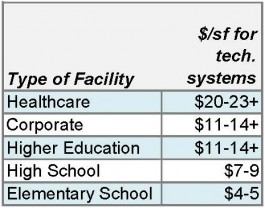Be Certain Everyone Reads
The Challenges of Preliminary Technology Construction Costs Estimating
By Amy Fortier
January 15, 2016
The construction costs for technology systems in facilities are historically some of the most underestimated costs when preliminary budgets are developed during master planning, pre-design, or conceptual planning phases of a construction project. In this post, we will look at why technology costs are undervalued, why it matters to the overall cost of a project, and some guidelines and solutions for improved cost estimates for future projects.
Undervaluing Technology Construction Costs
Technology systems – including IT, telecom, audiovisual, security, nurse call, and other low-voltage systems like public address and public radio, technology systems – are relatively new building systems. It wasn’t until the early 1990s that internet became a key requirement for successful business operations. Other building systems like mechanical, electrical, and plumbing systems had been around for over 100 years at that point. To this day, technology systems remain an afterthought in some building design.
Additionally, there can be huge variations in technology system costs. Your technology budget can be as large as you want it to be. Equipment, software, and system integration exists for every budget level. However, when a cost estimate for technology is included at a basic level, there will be limitations in the functionality and quality of the systems installed. Nowhere is the adage “You get what you pay for” more true than with technology.
Finally, it is tempting to use consumer costs in your construction cost estimate. Audiovisual equipment tends to have the most variability of all the systems. It’s natural to want to price AV equipment based on the consumer electronics prices we all have access to. However, consumer electronics are not warrantied and not often suited for commercial use. Plus, the raw cost of a flat-screen that you can buy at Costco, for instance, does not take into account the labor cost for installation or the infrastructure needed to cable the equipment back to a central server. More important, that Costco flat-screen is insufficient for the rigors of commercial use and will most likely have a higher lifecycle cost.
Why Does It Matter?
Developing accurate cost models early in the design or preplanning process enable the design team to make informed decisions on how to effectively allocate the entire facility budget without sacrificing functionality or aesthetics both for technology and the building as a whole. Telling a project owner late in design or even during construction that they cannot afford the technology they want and need is a difficult conversation to have. Realistic budgets at the beginning of the process reduce the need for value engineering under pressure or last-minute fundraising efforts.
Guidelines and Solutions
Below is a handy guide to rough technology cost estimates for various building types. These numbers are based on almost twenty years of historical data on the cost of technology systems and should enable you to determine if your technology budget is realistic for the type of facility you are planning. Keep in mind that these rough costs are based on basic assumptions about how we define technology from a construction perspective. This does not include typically owner-provided technology-related equipment normally considered to be outside the scope of construction such as computer servers and workstations, laptops/notebooks/tablets, scanners, copiers, printers, software, etc.
Recommended solutions to developing technology construction cost estimates consist of:
- Including a technology design consultant on your design team who can advise you of the best systems to provide the functionality you need for your facility, help you accurately define the budget for those systems, and design the systems to that budget.
- Contracting with a cost estimator or CM/GC who is familiar with the challenges of technology construction costs and having them work closely with the design team throughout the process.


